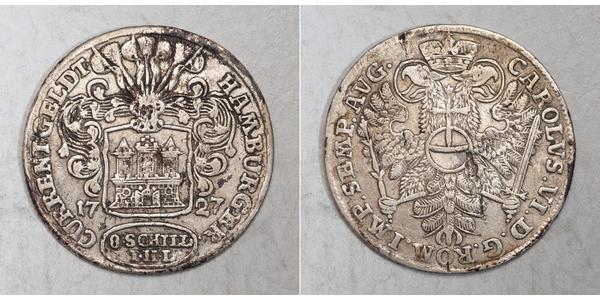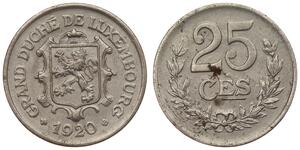8 Шиллинг (продана за $44.0)
1727, Hamburg (Free City), Charles VI. Nice Silver 8 Schilling (1/2 Mark) Coin.
Mint Year: 1727
Reference: KM-367.
Denomination: 8 Schilling (1/2 Mark)
Mint Master: IHL (Johann Heinrich Lowe)
Condition: Minor deposits (oxidation spots), otherwise VF+
Diameter: 30mm
Weight: 5.23gm
Material: Silver
In 1189 by Frederick I "Barbarossa" granted Hamburg the status f an Imperial Free City and tax-free access up the Lower Elbe into the North Sea. In 1265, a putative forged letter was presented to or by the Rath of Hamburg. This charter, along with Hamburg's proximity to the main trade routes of the North Sea and Baltic Sea, quickly made it a major port in Northern Europe. Its trade alliance with Lübeck in 1241 marks the origin and core of the powerful Hanseatic League of trading cities. On November 8, 1266 a contract between Henry III and Hamburg's traders allowed them to establish a hanse in London. This was the first time in history the word hanse was mentioned for the trading guild Hanseatic League. The first description of civil, criminal and procedural law for a city in Germany in German language, the Ordeelbook (Ordeel: sentence) was written by the solicitor of the senate Jordan von Boitzenburg in 1270. On August 10, 1410 civil commotion caused a compromise (German:Rezeß, literally meaning: withdrawal). It is the considered as the first constitution of Hamburg.
Charles VI (German Karl VI) (October 1, 1685 – October 20, 1740) was Holy Roman Emperor, King of Bohemia (as Karel II.) and Hungary (as Károly III.) from 1711 to 1740. From 1703 to 1711 he was an active claimant to the throne of Spain as Charles III.
Charles was born in Vienna, the second son of the Emperor Leopold I and of his third wife, Princess Eleonore-Magdalena of Palatine-Neuburg. He was given the baptismal names Karl Franz Joseph Wenceslau Balthasar Johann Anton Ignatius. His tutor was Prince Anton Florian of Liechtenstein.
Charles was the contracted heir of the Spanish Habsburgs. When Charles II of Spain made Philip V his heir, Louis XIV violated the contract. The dispute for the crown of Spain led to the War of the Spanish Succession.
After his older brother the Emperor Joseph I died suddenly in 1711, Charles returned to Austria. He succeeded immediately as King of Hungary and King of Bohemia. Later that year he was elected Holy Roman Emperor in Frankfurt.
Although Charles seems to have been clumsy in political affairs, the Austrian monarchy reached its widest expansion during his reign. His superior army was defeated by Bosnians in year 1737 in Battle of Banja Luka.
He married Elisabeth, eldest daughter of Louis Rudolph, Duke of Brunswick-Lüneburg. At the time of his death, his only surviving children were Maria Theresa and Maria Anna, so he had no living male heirs - a situation he had guarded against in the Pragmatic Sanction of 1713, which stated that his realm could not be divided and allowed that daughters also could inherit the throne from their fathers. When he died, the War of the Austrian Succession took place, but in the end the Pragmatic Sanction held up and his daughter succeeded him as Queen of Hungary and Bohemia and Archduchess of Austria. However, being a female, she was not elected Holy Roman Empress. Instead, Charles VII was elected. However, after Charles VII's reign, Maria Theresa's husband Francis III Stephen, Duke of Lorraine, was elected, ensuring that the Empire would continue in the Habsburg line.
Probably as a consequence of his years in Spain, he introduced the Spanish court ceremonial (Spanisches Hofzeremoniell) in Vienna and built the Spanish Riding School. Furthermore, the Reichskanzlei ("chancellory of the state") and the National Library were constructed during his reign and the Michaeler tract added to the Hofburg. Much was designed in baroque style in Vienna during Charles' reign.
He also had musical ambitions. Taught as a boy by Johann Joseph Fux, he composed, played the harpsichord, and now and then conducted the court's band.
There is some evidence that Charles' death was caused by consuming a meal of death cap mushrooms.
Karl succeeded more as a musician than as a statesman. He composed, played the harpsichord, and conducted the court band. Unfortunately, he performed those functions when he should have been leading the nation.

|
Добавил:
anonymous 2023-11-28 |
|
||
|
||
|
||
|
||
|
||
Одна из них
1/2 Цент Королевство Нидерланды (1815 - ) Медь Виллем III
в группе 10 монет / 10 цен
⇑




 English
English





-300-150-ZwusHgTycaAAAAGPadNVj7Mq.jpg)






